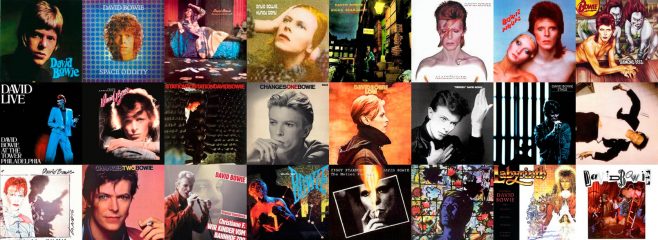
“Diamond Dogs” is David Bowie’s 8th studio album, originally released on 24th May 1974.
Between 18-20 October 1973, Bowie recorded a TV special at the famous Marquee Club in London called “The 1980 Floor Show“, exclusively for US TV (it was televised by NBC on 16 November 1973 as part of their “The Midnight Special” series). This would be the final performance by “Ziggy Stardust” and officially marked the end of an era. Bowie would never again perform with The Spiders From Mars, finalising the end of his wonderful collaboration with Mick Ronson (Ronson would go on to make a final cameo appearance on a Bowie studio album in 1993’s “Black Tie White Noise” on the track “I Feel Free“). You can watch the show here. There’s an unofficial album of the show that’s quite commonly available.
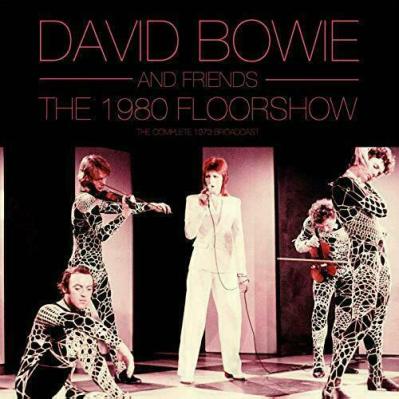
The set-list included the appearance of a couple of new songs “1984” and “Dodo” sung as a medley. These were songs Bowie had planned to include in a new project he was working on, a musical adaption of George Orwell’s brilliant depiction of a totalitarian nightmarish future, “1984“. Unfortunately, before things progressed too far, Orwell’s widow refused the unacceptably flamboyant Bowie any rights for the musical and so that was the end of any such West End show (Although I perfectly understand, I still haven’t fully forgiven her).
However, Bowie took much of what he had already written and instead adapted it to a new vision, a post apocalyptic future where the human race had been all but wiped out, replaced by humanoid tribes called the “Diamond Dogs” that patrol the ruins of Manhattan, now known as “Hunger City”. All rather bleak stuff instead.
But not quite as bleak as the challenge ahead of recording the resultant album. Bowie was keen for a fresh start and not only did he dispense with his backing band “The Spiders From Mars” but with producer Ken Scott as well, who had been sitting next to Bowie in the control room since “Hunky Dory“. Bowie would take on the sole duties of producer for the first time on one of his own albums, having already co-produced his last few albums and worked as producer on various other projects such as Lou Reed‘s masterpiece “Transformer” and Mott The Hoople‘s career defining “All The Young Dudes“.
The replacement of Ronson on lead guitar was solved by simply talking over those duties as well. Bowie was a useful multi-instrumentalist but to take on the huge responsibility of lead guitarist was a BIG call. But Bowie’s guitar work is actually one of the many highlights on this album, his raw somewhat unconventional style suiting perfectly much of the material. Bowie would also play saxophone and all the synthesizer parts as well.
The only remnants from his recent past were Mike Garson on piano, who played on the previous “Aladdin Sane” and “Pin-Ups” albums and Aynsley Dunbar on drums who had replaced Mick “Woody” Woodmansey on “Pin-Ups“. Renowned session drummer Tony Newman would also play on much of the album and on the subsequent tour.
Session supremo Herbie Flowers, who had worked previously in the studio with Bowie during the “David Bowie – aka Space Oddity” album and also on Lou Reed’s “Transformer” would take on bass duties and also play initially on the subsequent tour.
The final piece on the musical puzzle was Alan Parker, who would play the famous guitar riff on “Rebel Rebel” and the “wha wah” guitar sound that’s such a highlight on “1984“.
Recorded primarily at the Olympic Studios, London between January and February 1974, Bowie was obviously under a lot of stress with so much responsibility on his still relatively inexperienced shoulders. That Bowie would finish up with such an astonishing, ambitious, musically challenging, triumphant album while under such pressure really is an amazing achievement. This without any doubt is one of Bowie’s finest moments on record.
Beginning with an eerie howl, “Future Legend” starts things off rather ominously. With treated vocals, Bowie narrates the horrific existence that is Hunger City, “And in the death, As the last few corpses lay rotting on the slimy Thoroughfare” with Richard Rogers “Bewitched, Bothered and Bewildered” lurking in the background. It doesn’t sound like a nice place “Fleas the size of rats sucked on rats the size of cats, And ten thousand peoploids split into small tribes, Coveting the highest of the sterile skyscrapers“. The short piece ends with Bowie crying out to a screaming crowd that “Any day now, The year of the Diamond Dogs. “This ain’t Rock’n’Roll, This is Genocide.”
Dunbar’s drums then kick in as does Bowie’s distinctive guitar riff as we launch into the title track “Diamond Dogs“. Clearly heavily influenced by The Rolling Stones, Bowie does a pretty good job with his guitar playing, to the point many think it actually played by Ron Wood and/or Keith Richards (high praise indeed). Bowie’s vocals are sung with a certain swagger as he introduces us to the nightmarish near future existence that is Hunger City “Crawling down the alley on your hands and knee, I’m sure you’re not protected, for it’s plain to see, The diamond dogs are poachers and they hide behind trees, Hunt you to the ground they will, mannequins with kill appeal” and his latest character Halloween Jack who manages to survive by swinging around the skyscraper ruins ala Tarzan “The Halloween Jack is a real cool cat, And he lives on top of Manhattan Chase, The elevator’s broke, so he slides down a rope, Onto the street below, oh Tarzie, go man go“. If you like classic Stones, you’ll love this track with its blusey, basic rock vibe, but I regard this as the weakest moment of the album although it’s still an excellent track. It’s just a little two dimensional and over long compared to all the magic to come. Released as the second single off the album (but not in the US where 1984 was chosen instead), it reached a relatively disappointing No. 21 in the UK, Bowie’s weakest showing since making the big time.
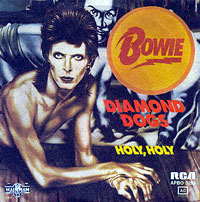
We have a few moments of silence before we hear the ever so slow build up comprising of swirling, backward playing swishes that’s the intro to the heart of the album, the truly magnificent “Sweet Thing / Candidate / Sweet Thing (Reprise)” suite. (Note: playing this on an iPod while jogging is really annoying because if seems for a minute or so that the iPod has stopped working). The band then kick in, with Garson’s piano a key feature as Bowie sings his first lines in an impossibly deep tone “It’s safe in the city to love in a doorway, Wrangle some screams from the dawn” before going higher up in his register as the song progresses. Conceptually about two lovers roaming the doomed Hunger City, Bowie famously uses his cut-up technique to conjure up a random set of lyrics that are typically cryptic and yet fit together perfectly to create beautifully surreal imagines. The music initially has a wonderful moody, understated presence that underpins one of Bowie’s finest vocal performances. Bowie sounds more conversational as he later states “I’m glad that you’re older than me, Makes me feel important and free” while the chorus exclaims “Boys, boys, it’s a sweet thing, sweet thing, If you want it, boys, get it here, thing“.
We then move into the amazing middle section, “Candidate“, with Newman’s drumming initially sounding like some military procession during the French Revolution. The pace begins to pick up, Bowie starting with “I’ll make you a deal, like any other candidate, We’ll pretend, we’re walking home ’cause your future’s at stake” as Bowie’s snarling guitar part becomes more dominant and the pace getting faster and faster. This is also the moment where Herbie Flowers shines best with a wonderful belting bass-line. Bowie is almost throwing random images at us as he sings lines such as “But there’s a shop on the corner that’s selling papier mache, Making bullet-proof faces: Charlie Manson, Cassius Clay“. The chorus, now just a interspersed repeated phrase, is much more frantic “If you want it, boys, get it here, thing“. Finally the piece reaches it’s crescendo as the lovers finally decide “We’ll buy some drugs and watch a band, Then jump in the river holding hands“.
Suddenly we “jump” into the third section of the piece “Sweet Thing (Reprise)” with Bowie’s saxophone signaling a change in proceedings as things slow down again. Bowie now beautifully sings “If you want it, boys, get it here, thing, ‘Cause hope, boys, is a cheap thing, cheap thing” as if there’s indeed little hope. Sadly just the one verse, this superb reprise has Bowie now hitting his higher registers with his magical final “It’s got claws, it’s got me, it’s got you…“. But there’s still one more highlight to come as Garson’s piano introduces us to a minute of frantic guitars, synthesizers/mellotrons and pulsing rhythm belting out a wall of sound that slowly hovers from speaker to speaker. Wow, I seriously mean wow indeed.
This suite is one of the finest moments of Bowie’s entire recorded career. It would be the centrepiece of the upcoming “Diamond Dogs” tour but sadly would not be performed live afterwards.
As the final guitar piece ends, it seamlessly joins up with the famous guitar riff that is “Rebel Rebel“. This is just classic rock and what would ultimately be Bowie’s final glam-rock era anthem, a celebration of being attracted to the different and the outrageous, regardless of whether you’re actually a boy or girl. It’s the couple from “Sweet Thing” ultimately not giving a shit. The classic line here “You’ve got your mother in a whirl, She’s not sure if you’re a boy or a girl” is typical Bowie as he later declares his love “Rebel rebel, how could they know?, Hot tramp, I love you so!“. Musically it again has that Rolling Stones feel to it, but this time the riff and performance is so much more catchy than it was on the title track. Alan Parker plays the main guitar riff superbly and is one of THE great rock ‘n’ roll guitar riffs. “Rebel Rebel” was the lead off single from the album and another huge hit, reaching No 5 in the UK. For the US market (where it only reached a disappointing No 64), a different recorded version was used for the single, one which Bowie generally favoured when performing it live. And performed live it was, being one of the most performed songs in Bowie’s career (and one of his most covered). There was no official video made for this, Bowie also ending his relationship with Mick Rock, but his appearance as the eye patched Halloween Jack on the Dutch TV show ToPPoP serves as the unofficial video. Watch it here.
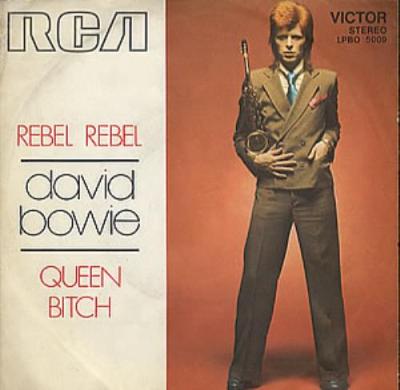
Side two starts with “Rock ‘n’ Roll with Me“, the song here which best signposts the path Bowie would next travel with his plastic soul “Young Americans” period. Side two mainly focuses on his shelved 1984 musical, but oddly not here, with this track having a much more optimistic vibe than elsewhere and being somewhat out of place. That said, it’s a lovely song with Garson’s piano featuring in front of a lovely rhythm and musical arrangement. It also contains another beautiful vocal performance, including some weird cut-up lyrics “I always wanted new surroundings, A room to rent while the lizards lay crying in the heat” with Bowie ultimately lamenting “When you rock and roll with me, No one else I’d rather be“. It can be viewed as Winston wooing Julia but I’m stretching things a little. I’ve also felt the dropped “Dodo” (discussed later) would have fitted in so much better.
“We Are the Dead” is simply a glorious, doom laden atmospheric masterpiece. Based on the pivotal line in George Orwell’s book when Winston after his affair with Julia confronts the realisation that “We are the dead. Our only true life is in the future. We shall take part in it as handfuls of dust and splinters of bone. But how far away that future may be, there is no knowing.” with the Thought Police certain to catch and dispose of them. As the Thought Police start to climb up the stairs to arrest the rebellious lovers, Bowie uses bizarre, surreal images to describe the sexual affair, doomed fantasies and the nightmare to come. Split into lyrical pairs, each of two verses that describes his current relationship followed by a longer verse comprising of his cut-up, doomed visions to come, the stunning vocals are either beautifully tender “One thing kind of touched me today, I looked at you and counted all the times we had laid” or depressingly chilling “We’re today’s scrambled creatures, locked in tomorrow’s double feature, Heaven’s on the pillow, its silence competes with hell“. At the end, it’s all too late “Oh dress yourself my urchin one, for I hear them on the stairs, Because of all we’ve seen, because of all we’ve said, We are the dead“. The music is just superb, a sound and feel that is almost uniquely Bowie, with a combination of parse keyboards, a basic, distorted drum beat, wonderful guitar squeals, synthesizers atmospherics and spooky backup vocals. Perhaps because of the studio wizardry involved in the recording and a vocal performance hard to replicate, this sadly was the only track on the album not to feature on the subsequent “Diamond Dogs” live shows and has never been played live as far as I know. A Bowie gem in every way.
Next comes “1984“, that had its first airing during “The 1980 Floor Show” and was planned to be the title track from the aborted 1984 musical. Featuring Alan Parker’s distinctive “Shaft”-like wah-wah guitar riff, a wonderful drum beat by Newman and sweeping strings arranged by Tony Visconti, this comes across as a big Broadway type number. Compared to the sparse live version of “The 1980 Floor Show” and the slower tempo version recorded earlier with “The Spiders From Mars” (see later), this highlights what great production work can do to enhance a song. Bowie’s vocals are again excellent with grim lines such as “They’ll split your pretty cranium, and fill it full of air, And tell that you’re eighty, but brother, you won’t care“. The glorious chorus spells out the authoritarian existence under the spell of Big Brother “Come see, come see, remember me?, We played out an all-night movie role, You said it would last, but I guess we enrolled, In 1984“. Notch this down as another Bowie classic contained within.
Despite all the previous quality, Bowie has a habit of ending an album on a high (think “The Bewlay Brothers”, “Rock ‘n’ Roll Suicide”, “Lady Grinning Soul”). “Big Brother” is just a wonderful track, one of Bowie’s finest, that describes Winston’s final, horrifying submission. Starting with a synthesized trumpet sound and a mellotron choir effect, it builds slowly before the drum beat kicks and the mainly keyboard instrumentation drives the music along, while in the background an acoustic guitar hangs in there to add some underlying structure. Bowie’s vocals are at their very best here, coming in with the cut-up lines “Don’t talk of dust and roses, Or should we powder our noses?“. The bridge is sublime as Bowie cries out “Please savior, savior, show us, Hear me, I’m graphically yours” before the soaring chorus details how Winston finally proclaims his love for Big Brother “Someone to claim us, someone to follow, Someone to shame us, some brave Apollo, Someone to fool us, someone like you, We want you Big Brother“. Following a second cryptic verse where the goal for Winston’s torture is briefly outlined “We’ll be living from sin, then we can really begin“, we hit the killer middle-eight where the music is temporarily reduced down to the basic acoustic guitar track “I know you think you’re awful square, But you made everyone and you’ve been every where, Lord, I think you’d overdose if you knew what’s going down” before heading to the final chorus sequences where each repeat of the chorus is more grandiose than the previous. Winston’s rebelliousness is finally and utterly defeated with the last line “We want you Big Brother…“. This is just classic Bowie encapsulated in 3:21 of brilliance. A feature of the “Diamond Dogs” tour, this made a surprise and delightful live resurrection during the “Glass Spider” tour in 1987.
The final “We want you Big Brother” then merges seamlessly into the thrilling final “Chant of the Ever Circling Skeletal Family“, as Winston’s brainwashing is finally complete as he numbly chants his love for Big Brother “Brother, Ooh-ooh, Shake it up, shake it up, Move it up, move it up” from the “Chestnut Tree Cafe” as he awaits his inevitable execution. Musically, it’s a grinding rhythm that circles around and around, each time with more percussion elements introduced, building and building until after 2 minutes it reaches its climatic “Bro bro bro bro bro bro bro bro bro bro…” as it echoes endlessly as it slowly fades away (or until the needles reaches the end of the groove). Conversely, this track could also represent the end of Side 1 as the inhabitants of Hunger City have a ritual dance around a campfire of burning mink coats. I swap my thinking with each play of the album…
Although “Diamond Dogs” is ultimately two incomplete projects, glued together on alternate sides of the same record, collectively it stands out as a Bowie masterpiece featuring some of his most brilliant work. It’s unconventional musical soundscapes combined with rock ‘n’ roll swagger is pure Bowie genius and his use of cut-up lyrics adds a layer of surrealism that nicely complements the whole piece. To say I love and adore this album would be an understatement.
After the album was finally recorded, Bowie got nervous during the mixing stage and asked old friend Tony Visconti if he would help with the mixing process. After the labours of recording “The Man Who Sold The World“, Visconti had spent much of the intervening years working with Marc Bolan’s T. Rex. who were massively successful at the time. Visconti gave the album the overall polish it deserved in the mixing studio which no doubt helped the quality of the overall final product. This would mark the start of Visconti’s second period of working with Bowie, which would end with the “Baal” EP in 1981.
Although the album was another commercial success for Bowie, reaching No. 1 in the UK and No. 5 in the US, it received some mixed reviews at the time. While “Sounds” magazine described it as his most impressive work since Ziggy, “Rolling Stone” described it as his worst album in 6 years. That’s mixed indeed. History however has been kind and is now more widely regarded as a highly influential forerunner for the upcoming punk movement and with NME voting it in as 447 in its list of top 500 albums all time. I would place it comfortably somewhere in the middle of my 50 all-time albums.
The album cover is one of Bowie’s most distinctive, featuring a gate-fold of a half Ziggy Stardust like-Bowie and half dog, although the original artwork had to be slightly censored with the dog’s genitals deemed a bit too risqué by RCA (some albums were initially released before they got the airbrush treatment and are very collectable today). The artwork was by renowned Belgian artist Guy Peellaert who would also go on to produce the artwork for The Rolling Stones album “It’s Only Rock ‘n’ Roll“. Bowie actually got the idea to use Peellaert after talking to Mick Jagger, but because Bowie records so fast (and The Stones so slow), was able to release “Diamond Dogs” first. This led Jagger to famously suggest to never wear a new pair of shoes in front of David Bowie. The album inner artwork featured a “Turner-like” landscape painting of the ruins of Hunger City.
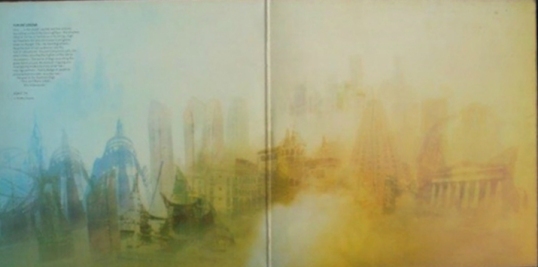
There have been a number of notable re-releases of the album over the years. In 1985, RCA released the album for the first time in CD format. Although the quality was not great, it’s reasonably collectable today. A much better release was the Rykodisc/EMI release in 1990, with much better audio quality, packaging and containing the following bonus tracks.
“Dodo“, sometimes known as “You Didn’t Hear It From Me” is the song first heard on the above mentioned “The 1980 Floor Show”. Describing the arrest of Winston’s neighbour Parsons, who was dobbed in my his brainwashed children, members of the “Juniors Spies”, the lyrics are the least obscure and the most comprehensible from the 1984 project. In this version recorded in September 1973, one of his last with the remaining Spiders From Mars, Bowie’s vocals here are a little weak compared to his vocal performances on the album tracks, using his “Ziggy” voice here more so than his somewhat deeper “Halloween Jack” voice. The music also has a more “conventional” rock arrangement (drums/bass/guitar/sax) with less use of keyboards/synthesizers. All that said, Dodo has real potential and a more updated recording would have fitted in perfectly as a replacement for the out of place “Rock ‘n’ Roll With Me”.
“Candidate” (Demo version) is a real treat. It’s totally different to the album version, both musically and lyrically. Again sounding like a track that belongs more on Ziggy Stardust than on Diamond Dogs, it has a really catchy rock based rhythm with Garson’s piano most prominent and an entertaining, often sexually explicit lyric that has little in common with the themes on either side of the Dogs album. Singing again with his higher pitched “Ziggy” voice, lines such as “Inside every teenage girl there’s a fountain
Inside every young pair of pants there’s a mountain” and “A matter of fact, That a cock ain’t a cock on a twelve inch screen” reminds of much of the sexual hilarity of “Sweet Head” and the line “I’ll make you a deal, I’ll say I came from from Earth and my tongue is taped” is pure Ziggy. This is one of my favourite Bowie rejects, which I enjoyed on many a bootleg before this official release.
Perhaps the best re-release was in 2014 when the album got a special 30th Anniversary treatment. It featured both a nice colour booklet on the recording of the album and a bonus disc that contained a number of edits and remixes, including the above mentioned two bonus tracks and the following previously unreleased tracks:
“1984/Dodo” is how Bowie initially envisaged these songs to be interlinked as originally performed on “The 1980 Floor Show”. This is an early recorded version from around September 1973 that is rather good. The music is sharp with the drum work particularly prominent although the mix is perhaps a little thin. With an effective use of strings and some nice backup vocals, it’s an interesting early view of how Bowie saw these tracks playing out in his planned musical. Bowie also sings with lots of inflection in his voice as one would in a musical format. A track that’s well worth checking out.
“Growin’ Up” is a cover of Bruce Springsteen’s song from his debut album “Greetings From Asbury Park N.J.“. Recorded during very early “Diamond Dogs” sessions, it features Ron Wood on guitar (where maybe Bowie got some guitar playing tips). Bowie was a big fan of early Springsteen and recorded a couple of Springsteen tracks. This one sounds a little like a demo and doesn’t have the polish of a completed track. Bowie does an OK US impersonation here but perfects this vocal style by the time he gets to “Young Americans“. There was always talk of a Pin Ups II album that would feature American songs, but sadly never materialised. This was previously released on the RykoDisc/EMI CD release of “Pin-Ups“.
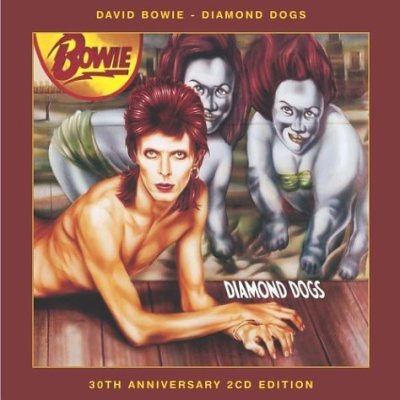
A remastered version of “Diamond Dogs” also featured in the “Who Can I Be Now? (1974-1976)” box set released in 2016.
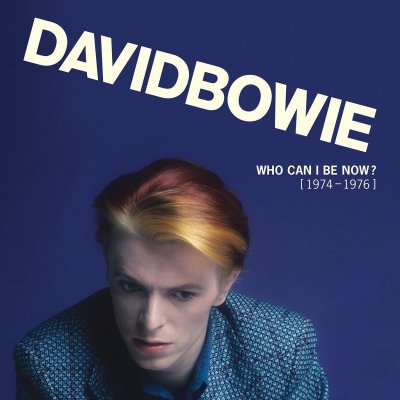
Finally for record collectors, a limited edition of “Diamond Dogs” was released on a red vinyl pressing in 2019 to celebrate its 45th anniversary.
Bowie would tour the album on one of the most ambitions theatrical tours in rock history, the “Diamond Dogs” tour. Featuring a massive on-stage set (designed by Mark Ravitz) of the ruin skyscrapers of Hunger City, each song was carefully choreographed (by Toni Basil) and featured different props and effects. One moment Bowie would be on a moving catwalk cascading down from the heights of Hunger City, then dancing around as if in a boxing ring, then in an actual glass asylum before emerging inside a giant hand before singing to a skull as if a Shakespearean scene before floating in the air in a cherry picker singing “Space Oddity” into a red phone and on and on when the theatrics. It was one of the most visually stunning rock shows of all time, this being 1974 way before such massive rock ventures became more common.
But having effectively a full Broadway show experience on the road come at a huge cost and risk of things going wrong. Things would often break down and cause Bowie no end of stress (once he was famously left stuck up in the air when the cherry picker broke down, forcing Bowie to sing a number of additional songs whilst suspended 100 feet in the air). After a few months and a break in the tour, Bowie decided to strip it all back and basically threw the set away, transforming the show into what was renamed “The Soul/Philly Dogs” tour. Sadly because of the stress of it all and huge expense, the tour would only include North America dates and never made it elsewhere, not even the UK.
The band changed throughout the tour but was notable in that it included for the first time a very young Earl Slick on guitar and later on Carlos Alomar as well, who would both work extensively with Bowie in the future. Other notable members of the band (who were forced to play practically out of sight on stage left) include David Sanborn on saxophone and Luther Vandross on backing vocals, both to have huge musical careers.
The “Diamond Dogs” tour was immortalised on the somewhat bizarre live album “David Live“. Recorded with the band upset by a pay dispute regarding royalties, the music comes across as stale, lethargic and lacking any sense of energy, whilst Bowie’s vocals sound strained and tired as he struggles to hit anything above his middle register. The recording is also just terrible, with the very thin sound coming across as if there’s only the one instrument playing at a time. Even Tony Visconti’s attempts to rescue things at the mixing stage comes too late to address things adequately. When I first got this album for Christmas many many moons ago (it was a double-album, how exciting), I was initially extremely disappointed by it all. But I’ve grown to really like it now, appreciating it as a document on an extraordinary time in Bowie’s career that showcases some of his very best songs in a uniquely different light. That said, I highly recommend later superior remixes of this album, especially the 5.1 surround sound version of the album that was released in 2005 in which the sparse recording is perfectly suited to the 5.1 experience.

For Record Store Day in 2017, a new live album from this period was released called “Cracked Actor (Live Los Angeles ’74)” that was recorded 5 September 1974 on the LA leg of the tour. Overall, I think it a better listening experience with much better performances overall and features then two news songs in “It’s Gonna Be Me” and “John, I’m Only Dancing(Again)“, neither of which managed to make it on the upcoming “Young Americans” album. This new live album was released later in 2017 in CD format. Well worth checking out.
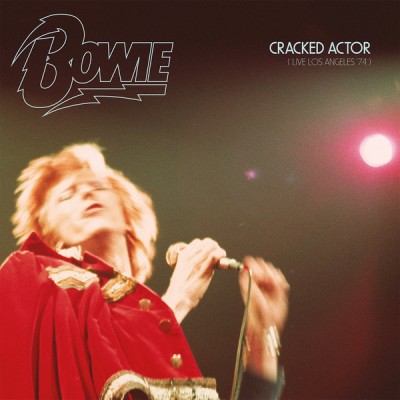
It’s been announced there will be yet another live album from this period, due out for Record Store Day 2020 (sadly postponed due to the Coronavirus epidemic) called “I’m Only Dancing (The Soul Tour 74)“, recorded at the Soul/Philly shows in Nashville and Detroit. Something to look forward to…
It’s also well worth checking out a brilliantly insightful BBC documentary from this period also called “Cracked Actor“. Recorded in LA during the “Diamond Dogs” tour, it offers a rare behind the scenes look at an extremely thin, paranoid Bowie as he discusses his career and writing processes. Featuring various clips of his live performances during the tour, it’s one of the very few glimpses we have of these extraordinary live shows.
“Diamond Dogs” is David Bowie at his very finest, a remarkable album that has aged extremely well considering it’s fast approaching 50 years old. I instantly loved it when I first heard it and I love it still to this day. It’s an album that is best listened to from start to finish (hearing say just “Candidate” on shuffle is so very annoying). Marking the official end of Bowie’s “glam-rock” period, he would moved on next to his Plastic Soul period and then onto numerous other musical genres and styles in the decades to come.
However, as much as I adore this album, Bowie had already recorded two other albums that I think just pip this one as being his very very best. But that’s a story for another day…
Best Tracks: “Sweet Thing/Candidate/Sweet Thing (Reprise)“, “Big Brother“, “Chant Of The Ever Circling Skeletal Family“
